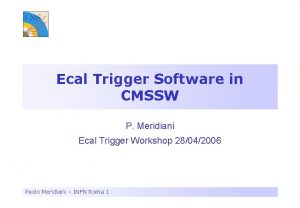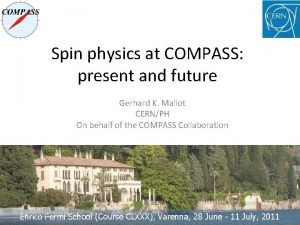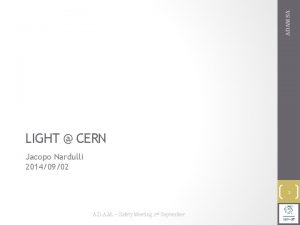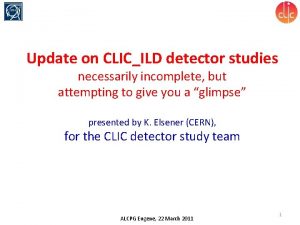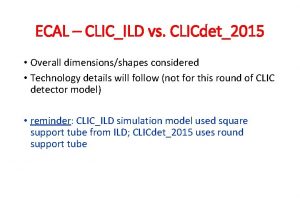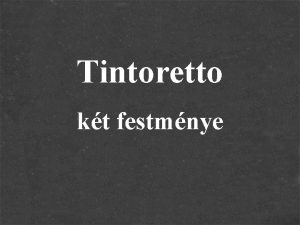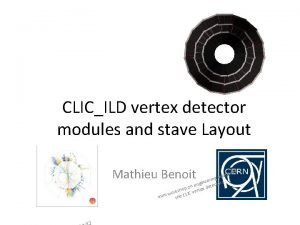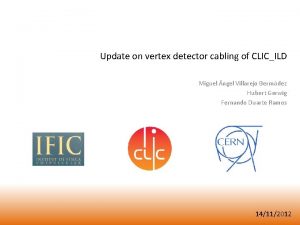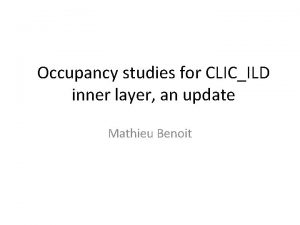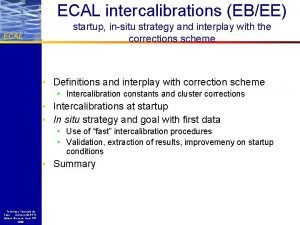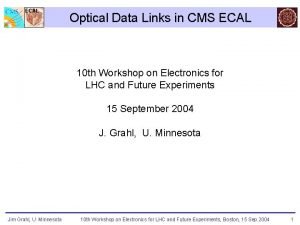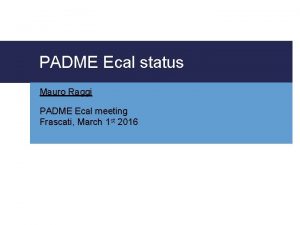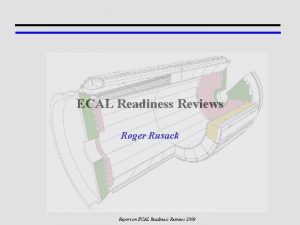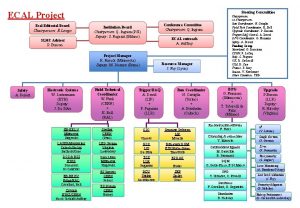ECAL Studies for the CLICILD detector Jacopo Nardulli


















- Slides: 18

ECAL Studies for the CLIC_ILD detector Jacopo Nardulli, CERN LCD CALICE Collaboration Meeting Heidelberg 14 -16/9/2011 ECAL Studies at CLIC 1/14

Why the ECAL is as it is ? • The LOI ILD Ecal structuring comes from an optimization from H. Videau available here ECAL Optimization from H. Videau • A few scenarios with different nr of layers and different absorber thickness are considered • Similar studies have also been done by M. S. Amjad and have been presented at the CALICE Meeting in Casablanca 16/9/2011 ECAL Studies at CLIC 2/14

Goal of this study • Attempt a similar optimization on the CLIC version of the ILD detector • To have an ECAL with less layers, therefore cheaper, but without degradation of the performance 16/9/2011 ECAL Studies at CLIC 3/14

Two possible studies • Fix the radiation length • But decrease the Nr of ECAL layers • Less expensive, energy resolution can be worse, as the pattern recognition • How to ? • Varying nr of layers and absorber thickness, • not the Si thickness • Vary the radiation length • And decrease the Nr of ECAL layers • Less expensive, overall performance changes 16/9/2011 • If I change the X 0, can have more leakage into the HCAL • Varying nr of layers, absorber thickness and studying performance as a function of the X 0 ECAL Studies at CLIC 4/14

Now only first study: Different ECAL models • Altering the number of layers and their absorber thickness in such a way that Total Absorber thickness in the detector remains the same. • The analyses included in this talk were done with Single Photon with θ and φ varying in the full range and Energies of 1, 100 and 500 Ge. V and using Pandora. PFA • Default model 20 layers in 1 st stack and 9 layers in 2 nd stack • Study in two steps, • first keeping the thickness of first and second stack also unchanged • then varying the ratio 16/9/2011 ECAL Studies at CLIC 5/14

Disclaimer • Here showing the Energy Resolution vs. the Energy and using Single Gaussian fits • To get the energy resolution I am NOT using the official Marlin. Processor which calculates rms 90 and mean 90 • So do not look at absolute numbers, but at the general trend of the plots 16/9/2011 ECAL Studies at CLIC 6/14

Results: changing Nr of layers in 1 st stack Mean Rec. Energy vs Input Energy 16/9/2011 ECAL Studies at CLIC 7/14

Results: changing Nr of layers in 1 st stack Mean Rec. Energy vs Input Energy Res. vs Input Energy 16/9/2011 ECAL Studies at CLIC 8/14

Results: changing Nr of layers in 2 nd stack Energy Res. vs Input Energy 16/9/2011 ECAL Studies at CLIC 9/14

Results: changing Nr of layers in 1 st and 2 nd stack Energy Res. vs Input Energy Preliminary conclusion: à Can go from 29 layers to 25 with hardly any loss in performance à Need to change ratio of X 0 in 1 st and 2 nd stack to further reduce nr of layers –now roughly 50%: 50%. Can try 40 -60 ! 16/9/2011 ECAL Studies at CLIC 10/14

Results: changing Nr of layers in 1 st and 2 nd stack and different ratios à Reducing the X 0 in 1 st stack and changing the ratio does not seem to help. à Now try something else 16/9/2011 ECAL Studies at CLIC 11/14

Results: just 1 stack Preliminary results à Using just 1 stack with less, but thicker, layers does not seem to degrade the energy resolution dramatically. 16/9/2011 ECAL Studies at CLIC 12/14

Conclusions à First attempt of an optimization of the ECAL for CLIC_ILD à First results show that we can go from 29 to 25 layers with a small loss in performance à Reducing the X 0 in 1 st stack and changing the ratio does not seem to help. à Using just 1 stack with less, but thicker, layers does not seem to degrade the energy resolution dramatically. 16/9/2011 ECAL Studies at CLIC 13/14

Next steps à Preliminary studies, lots of things not considered à i. e. is it right to use PFA ? à should I use Garlic ? à Is the energy resolution the main/only parameter to be used to understand possible loss of performance caused by having less layers ? à Finish 1 st study à More statistics à Use RMS 90 à Move to the 2 nd study à Performance as a function of the X 0 16/9/2011 ECAL Studies at CLIC 14/14

Backup 16/9/2011 ECAL Studies at CLIC 15/14

Results: changing nr layers in 2 nd stack Mean Rec. Energy vs Input Energy 16/9/2011 ECAL Studies at CLIC 16/14

Only 1 layer 16/9/2011 ECAL Studies at CLIC 17/14

Results: changing Nr of layers in 1 st and 2 nd stack Mean Rec. Energy vs Input Energy 16/9/2011 ECAL Studies at CLIC 18/14
 Ecal
Ecal Uberthon
Uberthon Ecal
Ecal Jacopo ortalli
Jacopo ortalli Jacopo bassano ultima cena
Jacopo bassano ultima cena Indicatcher
Indicatcher Scuola jacopo barozzi modena
Scuola jacopo barozzi modena Jacopo tattini
Jacopo tattini Rhéa silvia
Rhéa silvia Rancati jacopo matteo
Rancati jacopo matteo Paradigm shift from women studies to gender studies
Paradigm shift from women studies to gender studies Tack för att ni har lyssnat
Tack för att ni har lyssnat Smärtskolan kunskap för livet
Smärtskolan kunskap för livet Karttecken
Karttecken Typiska novell drag
Typiska novell drag Fimbrietratt
Fimbrietratt Frgar
Frgar För och nackdelar med firo
För och nackdelar med firo Matte större än tecken
Matte större än tecken

